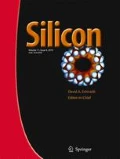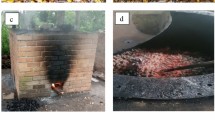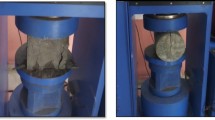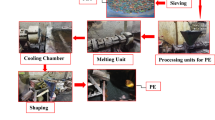Abstract
The increasing sustainability awareness in the concrete industry has called for a need to find ways to partially or totally replace Portland cement in concrete. The imminent need to replace Portland cement is as a result of its production process is energy-intensive and a consequential amount of carbon dioxide being emitted into the atmosphere. In a quest to improve the sustainability of concrete mixtures, this study was carried out to investigate experimentally and statistically the performance of concrete made with coconut shell ash as partial replacement of Portland cement (PC). Coconut shell ash was used to replace 10% PC in the form of supplementary cementitious material and as an alkali-activated binder. The experimental program involves evaluating the workability, compressive strength and split tensile strength of the developed mixtures. In addition, the effect of two curing media on the resulting mechanical properties was investigated. Based on the experimental study, statistical models were developed using multiple regression analysis. Experimental results showed that the compressive strength and split tensile strength increased by 7.7% and 29.4% when the concentration of the sodium hydroxide was increased from 2.5 to 10 M respectively. Results from the models developed showed good agreement with the experimental results.
Similar content being viewed by others
References
Andrew RM (2018) Global CO2 emissions from cement production, Earth Syst. Sci. Data
Adesina A (2018) Concrete Sustainability Issues, no. 38th cement and concrete science conference, UK
Awoyera PO, Adesina A and Gobinath R (2019) Role of recycling fine materials as filler for improving performance of concrete - a review, Australian Journal of Civil Engineering
Adesina A (2018) Use of Rice Husk in concrete: Review of mechanical properties, J. Curr. Constr. Issues, no. September
Awoyera P and Adesina A (2019) Durability properties of alkali activated slag composites: short overview, Silicon
Sivakrishna A, Adesina A, Awoyera PO, and Rajesh Kumar K (2019) Green concrete: a review of recent developments, Mater. Today Proc., Sep
Awoyera PO, Adesina A, Sivakrishna A, Gobinath R, Kumar KR, and Srinivas A (2019) Alkali activated binders: challenges and opportunities, Mater. Today Proc
Gunasekaran K, Annadurai R, and Kumar PS (2012) Long term study on compressive and bond strength of coconut shell aggregate concrete, Constr. Build. Mater
Gunasekaran K, Kumar PS, and Lakshmipathy M (2011) Mechanical and bond properties of coconut shell concrete, Constr. Build. Mater
Santhosh Kumar M, Prasath Kumar VR, and Gunasekaran K (2016) Study on mechanical properties of high strength concrete using coconut shell as coarse aggregate, Int. J. Chem. Sci
Uday Bhaskar M, Manasa S, and Anith Kumar T (2019) Concrete mix using solid waste aggregates (coconut shell concrete), Int. J. Innov. Technol. Explor. Eng
Olanipekun EA, Olusola KO, and Ata O (2006) A comparative study of concrete properties using coconut shell and palm kernel shell as coarse aggregates, Build. Environ
Chandran KP, Natrajan M, and Meiaraj C (2016) Impact resistance of Fly ash based geo polymer concrete using coconut shell aggregate, Int. J. Civ. Eng. Technol
British Standards Institution (1996) BS 12:1996 Specification for Portland cement
B. E. 197–1 C. British Standard Institution (2011) Composition, specifications and conformity criteria for common cements, BSI
BS EN 12350–1:2009 (2009) Testing fresh concrete. Slump-test, Eur. Norms
Bs En 206:2013 (2013) BSI Standards Publication Concrete — Specification , performance , production and conformity, Br. Stand
British Standard (2009) Testing hardened concrete - part 6: tensile splitting strength of test specimens, BS EN 12390-62009
Fang G, Ho WK, Tu W, and Zhang M (2018) Workability and mechanical properties of alkali-activated fly ash-slag concrete cured at ambient temperature, Constr. Build. Mater
Neville A (2012) Properties of concrete - 5th Edition
Awoyera P and Adesina A (2019) A critical review on application of alkali activated slag as a sustainable composite binder, Case Stud. Constr. Mater
Ibrahim M, Megat Johari MA, Maslehuddin M, Rahman MK, Salami BA, and Mohamed H. D (2019) Influence of composition and concentration of alkaline activator on the properties of natural-pozzolan based green concrete, Constr. Build. Mater
Acknowledgements
The authors would like to express gratitude to the University of Lagos for providing an enabling environment to conduct this research work.
Author information
Authors and Affiliations
Corresponding author
Additional information
Publisher’s Note
Springer Nature remains neutral with regard to jurisdictional claims in published maps and institutional affiliations.
Rights and permissions
About this article
Cite this article
Ikponmwosa, E.E., Ehikhuenmen, S., Emeshie, J. et al. Performance of Coconut Shell Alkali-Activated Concrete: Experimental Investigation and Statistical Modelling. Silicon 13, 335–340 (2021). https://doi.org/10.1007/s12633-020-00435-z
Received:
Accepted:
Published:
Issue Date:
DOI: https://doi.org/10.1007/s12633-020-00435-z




